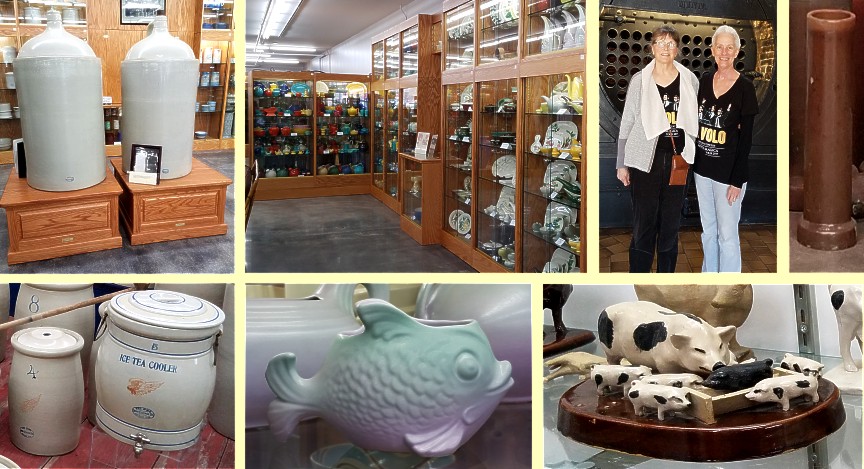Kansas Snapshots by Gloria Freeland - April 14, 2017
What a crock!
Our spring-break destination was Minneapolis to see the Italian singing trio, Il Volo. But husband Art planned the trip
as a leisurely one so our friend Jo and I could enjoy the journey. We traveled along the western side of the Mississippi
River from Jo’s home in southwestern Wisconsin, stopping at historical markers - or “hysterical” markers, as Art and I like
to call them. On the way home, we decided to make an extended stop at Red Wing, Minnesota to visit the pottery museum.
I had seen numerous examples of Red Wing pottery in antique shops through the years and Art’s Uncle Art was a collector
who had dozens of the crocks scattered throughout his home. Husband Art even has a small bowl acquired from his uncle’s
collection quite by accident - literally. One time when the two were visiting, his uncle handed Art the bowl so he could
take a closer look. The bowl slipped out of Art’s fingers and fell to the floor, breaking.
“Oops! I guess that’s your Christmas present this year!” his uncle said.
Art kept the pieces, glued them together and placed the bowl on a shelf at work as a reminder of the incident.
The spacious museum building had display cases filled to the brim with crocks and other pottery pieces. The items ranged
in size from small bowls to 70-gallon jugs - the largest ever made by the Red Wing Union Stoneware Co. One of those
large ones had even been displayed at the 1923 Minnesota State Fair. Merchants as well as homeowners used the crocks and
jugs to store a variety of items - pickles, relishes, oysters, butter and iced tea. Some had the names of retailers or
wholesalers on them - an early way stores advertised their wares.
I was surprised to see that the company also made sewer pipes, candle holders, ashtrays, cookie jars, planters, and
figurines. There was also dinnerware with names such as Morning Glory, Turtle Dove, Bob White, Normandy, Orleans, Brittany,
Nassau and Blossom Time.
An internet search revealed that the area near Red Wing was originally inhabited by the Native American Dakotah tribe, who
spent their summers hunting and fishing along the Mississippi River bluffs. French Voyageurs first visited in 1680, and,
some 200 years later, the first European settlers came. Chief Red Wing offered his friendship and the settlement became known
as Red Wing in his honor.
German immigrants who arrived in the 1860s noticed the local clay was perfect for making stoneware for food storage, and
that led to the establishment in 1877 of the Red Wing Stoneware Company. Industrialization moved people from the farms into
towns and cities, prompting the development of sewer systems. The Red Wing Sewer Pipe Company was formed to meet the need for
ceramic sewer pipes. Eventually, the two companies merged, and the Red Wing Union Stoneware Company was born.
But the good years didn’t last. Refrigerators began appearing in homes in the early 20th century and the demand for
crocks and jugs declined. The company turned to making flower pots and vases, then dinnerware, and finally a wide variety of
art pottery. In 1936, the name was changed to Red Wing Potteries.
More than 100 hand-decorated patterns were made and as many as a million pieces were produced each year. But imported
dishes and a union strike in 1967 meant the end of production for Red Wing Potteries. The last president purchased the
company from the other shareholders and operated it as a retail business with the name Red Wing Pottery, hiring potters to
hand-throw clay pots. In 1984, the Red Wing Stoneware Company was reborn, making two companies in the city.
But by the end of 2013, Red Wing Pottery was considering closure. The owners of the Red Wing Stoneware Company decided to
bring both operations back together. The new company, Red Wing Stoneware and Pottery, currently makes microwave- and
dishwasher-safe products and offers tours to visitors.
The Red Wing Collectors Society was established in 1977, and currently has more than 3,500 members in the U.S. and Canada.
Members help the museum preserve the history and have an annual July convention in Red Wing.
Up to our eyeballs in stoneware, Jo and I wandered into the gift shop. I was immediately taken by a pink Morning Glory
plate. It was a vintage piece and not a reproduction. The saleswoman told me that people in the collectors' society donate
pieces to raise money for the museum. When I discovered it was just $10, it had to come home with me.
We learned that some collectors do go a bit crazy. A Nebraska couple had 5,000 Red Wing items. They created a 1,700
square-foot museum in Lincoln. But they wanted the pieces to “come home” and so, donated their entire collection to the museum
in Red Wing.
We eventually piled into the car with images of jugs, pots, sewer pipes and other stoneware still occupying our
thoughts. Until I saw the museum and read about the company, I never dreamed that “What a crock!” could be a compliment.
